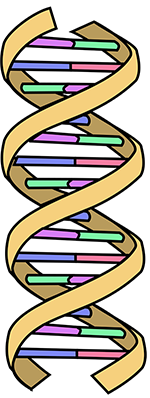How Can DNA Replication Be Modeled?
Objectives:
- Build a model of DNA using colored paper clips and use the model to illustrate how semi-conservative replication takes place.
- Compare the actions of DNA polymerase to DNA helicase.
- Summarize how semi-conservative replication reduces errors in copies
Procedure: You will construct a double-stranded Human Growth Hormone (hGH) gene using colored paperclips.
Adenine (A) = blue
Thymine (T) = white
Cytosine (C) = red
Guanine (G) = geen
Step 1: Build Human hGH DNA
Link the appropriate clips togather to create 2 stands of hGH according to the following modified sequence. The actual gene consists of 573 bases. Remember, to follow the base-pair rule.
A-A-G-C-T-T-A-T-G-G-T-C-C-C-G-G-A-C-G-A-A-G-C-T
Step 2: Unzip DNA
Replication of DNA is called semi-conservative because the process saves, or conserves, half of the original strand. Helicase enzymes in the cell first UNZIP the DNA molecule. Separate the two sides of the DNA molecule you built to model this process.
Step 3: Build New Strands
DNA polymerase builds a new half on each side of the unzipped strand, following the base pair rule. Add new paperclips of the appropriate color to each side of the unzipped molecule. When finished, you should have two complete doublestranded DNA molecules now.
Discussion:
1. How would this method or replication reduce errors (mutations) in newly constructed DNA?
2. Compare DNA helicase to DNA polymerase. What are their roles in replication?
3. What is the base-pair rule? How does it come into play during replication?
